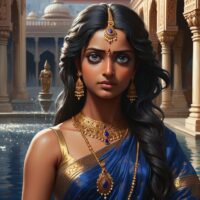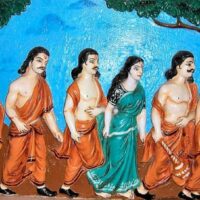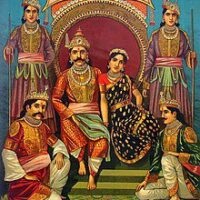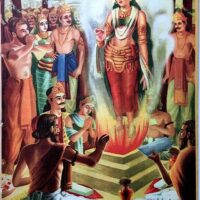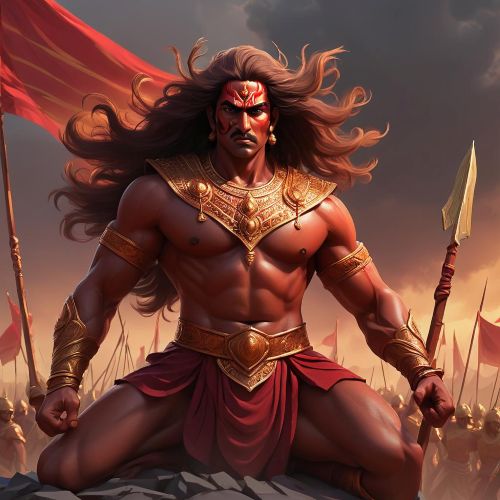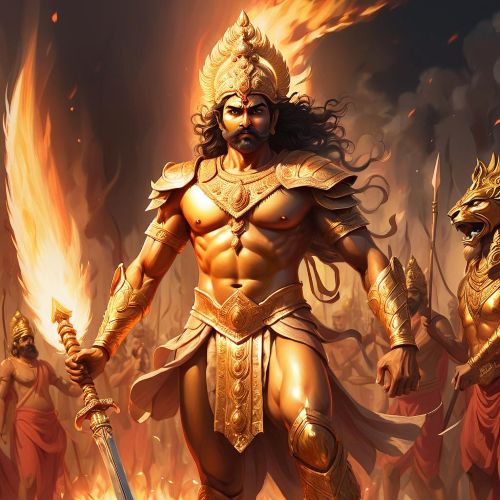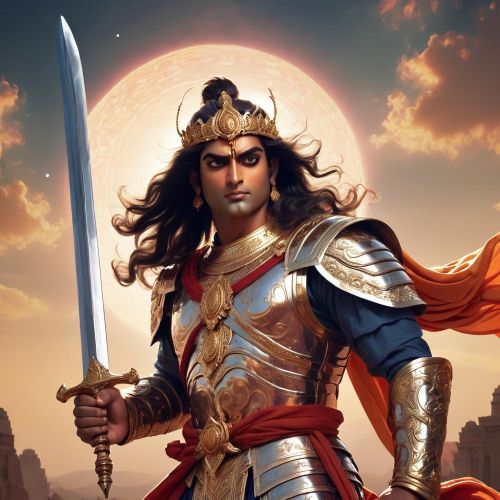Draupadi : The Pandava Queen
Listen
At a glance
| Description | |
|---|---|
| Origin | Indian Mythology |
| Classification | Mortals |
| Family Members | Draupad (Father), Prishati (Mother), Dhrishtadyumna (Brother), Pandavas (Husbands) |
| Region | India |
| Associated With | Royalty |
Draupadi
Introduction
Draupadi, a name synonymous with fire, resilience, and unwavering spirit, is a central character in the epic Mahabharata. Her life story, woven with immense beauty, injustice, and a fight for righteousness, continues to resonate with audiences today. Draupadi, the daughter of King Drupada of Panchala, is renowned for her beauty, courage, and polyandrous marriage to the five Pandava brothers—Yudhishthira, Bhima, Arjuna, Nakula, and Sahadeva. Born during a yajna (fire sacrifice) organized by her father, Draupadi’s story is one of strength and controversy, making her a compelling figure in Hindu mythology.
Physical Traits
Draupadi’s physical beauty is legendary in the Mahabharata. Described with dark, captivating eyes, long flowing black hair, and skin the color of dusk, she earned the name “Krishnaa.” Her fragrance was said to travel for miles, giving her the epithet “Yojanagandha” (one whose fragrance travels a yojana, an ancient Indian unit of distance). Draupadi’s beauty was not just physical; it reflected her inner strength and fiery spirit. Renowned across ancient Indian kingdoms, her allure influenced events and alliances throughout her life story.
Family
Draupadi was born from a sacrificial fire (yajna) performed by King Drupada of Panchala, emerging fully grown and radiant, a symbol of divine intervention destined for an extraordinary life intertwined with the fate of the Kuru dynasty. This unusual birth earned her the name Yajnaseni, meaning “born from the sacrificial fire.” Her twin brother, Dhrishtadyumna, also emerged from the same yajna. Draupadi’s unconventional birth marked her unique destiny and pivotal role in the Mahabharata. At her swayamvara (bride-choosing ceremony), through an unusual turn of events, Draupadi became the wife of the five Pandava brothers—Yudhishthira, Bhima, Arjuna, Nakula, and Sahadeva. This polyandrous marriage, resulting from a misunderstanding, became a defining aspect of her life. Her parents were King Drupada and Prishati, and her sibling was Dhrishtadyumna.
Other names
Draupadi, known by various names that reflect different aspects of her life, played multifaceted roles throughout the Mahabharata. As Panchali, she is linked to her kingdom of Panchala, while Yajnaseni highlights her unique birth from a sacrificial fire. Her dark complexion earned her the name Krishnā. During her exile, she disguised herself as a maid named Sairindhri, and Panchami, meaning “fifth one,” underscores her position as the wife of five husbands. These names collectively portray her as a princess, wife, queen, and servant, illustrating the diverse roles she embodied in the epic.
Powers and Abilities
Draupadi was not merely a beautiful woman; she possessed a sharp intellect, unwavering courage, and a strong sense of justice. Her wit was evident during the game of dice, and her demand for revenge after her humiliation showcased her defiance in the face of adversity. The Mahabharata hints at her possessing some divine abilities, although their extent remains subject to interpretation. Draupadi’s fearlessness in confronting those who harmed her or her family, combined with her humility and austerity despite her royal status, highlights her remarkable qualities. Her intellectual prowess and eloquence, often challenging norms and standing up for justice, were further underscored during her swayamvara, where she demonstrated agency and determination by tasking suitors with a difficult challenge.
Modern Day Influence
Draupadi’s story continues to spark discussions and debates in modern times. Some view her as a symbol of female subjugation, forced into a polyandrous marriage. Others see her as a powerful woman who challenged societal norms, holding her own in a male-dominated world. Draupadi’s unwavering pursuit of justice resonates with feminist movements, highlighting the importance of speaking out against injustice.
Her story also raises questions about the concept of marriage and female agency. While the polyandrous marriage might seem unusual in a modern context, Draupadi’s fierce loyalty to all her husbands and her active participation in shaping the course of events showcase her agency within the societal framework of the time.
Draupadi’s enduring influence can be seen in various aspects of modern life. She is depicted in numerous artistic representations, from paintings and sculptures to theatrical productions and television shows. Her story continues to be retold, reinterpreted, and analyzed, serving as a source of inspiration and sparking discussions about gender roles, social justice, and the complexities of human relationships.
Related Images
Frequently Asked Questions
What is lorem Ipsum?
I am text block. Click edit button to change this text. Lorem ipsum dolor sit amet, consectetur adipiscing elit. Ut elit tellus, luctus nec ullamcorper mattis, pulvinar dapibus leo.
What is lorem Ipsum?
I am text block. Click edit button to change this text. Lorem ipsum dolor sit amet, consectetur adipiscing elit. Ut elit tellus, luctus nec ullamcorper mattis, pulvinar dapibus leo.
What is lorem Ipsum?
I am text block. Click edit button to change this text. Lorem ipsum dolor sit amet, consectetur adipiscing elit. Ut elit tellus, luctus nec ullamcorper mattis, pulvinar dapibus leo.
What is lorem Ipsum?
I am text block. Click edit button to change this text. Lorem ipsum dolor sit amet, consectetur adipiscing elit. Ut elit tellus, luctus nec ullamcorper mattis, pulvinar dapibus leo.
What is lorem Ipsum?
I am text block. Click edit button to change this text. Lorem ipsum dolor sit amet, consectetur adipiscing elit. Ut elit tellus, luctus nec ullamcorper mattis, pulvinar dapibus leo.


